A few months ago, while walking over a bridge in Whatcom Falls Park, I saw a small black bird that I did not recognize swimming in and out of the rapid water of Whatcom Creek. I learned that is bird is an American Dipper, uniquely the true aquatic songbirds. It is found in rushing streams, rivers, and ponds, and often builds its nest under bridges and trestles. Is frequently flashes a white eyelid. Since this bird is not a rarity, but not a bird you can find everyday, I was very happy to watch this bird at the same time, same place for about a week. I did not see it after that.
Colorful Surf Scoters
March 28, 2009These beautiful birds are the largest and most colorful of the three different type of scoters (White-winged and Black being the other birds) found along the Georgia Straight and in surrounding waters. They are usually in large rafts, sometimes mixed with other birds, and generally feed in deep water. I was lucky to find them so close to shore one day at Semiahmoo Park. These birds have a fairlyextensive winter range along the Pacific Coast, and a somewhat more limited range along the Atlantic Coast.
As with most birds, it is the male that has the colorful beak and glossy black feathers. The females are brown and indistinct. Besides its unusual tri-colored beak, the male Surf Scoter also has a white patch on his forehead and the nape of his neck. It is hard to confuse a Surf Scoter for anything else.
Breeding pairs form in the winter, and the male will defend the female from intruders by staying close by. The males level of fidelity is high and he is known to continually return to a mate eve if she is injured or dead. Surf Scoters generally eat crustaceans, fish eggs, insects and vegetable matter, depending on time an location.
To see these beautiful and gregarious birds, go to an area of coast known for sea birds, bring your binoculars and wait.
American Bald Eagles at Semiahmoo Park
March 27, 2009My favorite place to birdwatch is at Semiahmoo Park in Blaine, Washington. It is designated an important stop on the Pacific Flyway. Right now, the Spring migratory season is just beginning, which gives me the possibility of seeing migrating birds that are not local. Yesterday, I took some my favorite photos ever, which I will post over time.
What made a big impression on me was an extremely large juvenile eagle who was planted on the top of a newly installed tree stump placed next to a walking trail. I have never had an eagle look at me in such a hostile, menacing manner, and so closely monitor my movement without attempting to fly away to another tree. I took China tightly on her lease and walked by as quickly as as I could.
The juvenile eagle is the dark one….it takes 3 years for a bald eagle to fully develop a while crown. There are also photo’s of an adult eagle that I took on a previous trip…standing on a tree right outside the woman’s restroom. I was startled to see an eagle so close, and it took off shortly thereafter.
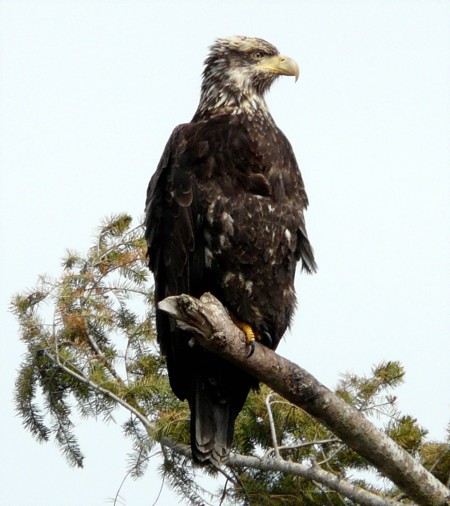
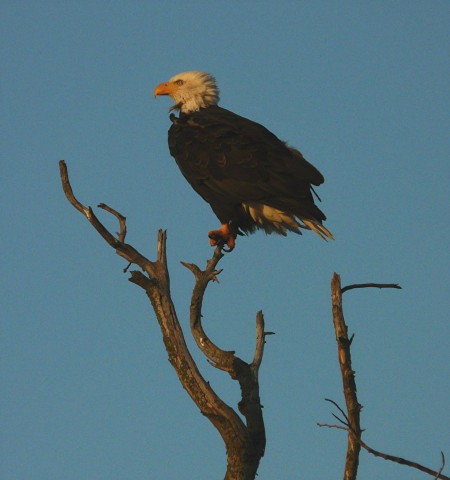
A Great Way To Start The Day
March 26, 2009As many of you know, I am not what could be called an early riser. However, this is often the best time for birdwatching. I got up early this morning and was rewarded when I looked out at my bird feeders and saw a large Northern Flicker feeding some suet. Got a few photos before he flew away and learned that it is definately time to clean the outside windows.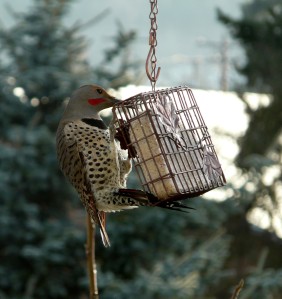

The Beautiful Grey Skies of Bellingham
March 25, 2009In Bellingham, everything is beautiful…. the grey skies, the dark clouds and mist, even the effluence from the discharge pipe at the Port of Bellingham facility plant. The first photo is of Lake Whatcom from Bloedel Donovan Park, and the other photos are of the Port of Bellingham facility and the Bay.
Post Point Herons in Bellingham, 2008
March 24, 2009Here are some photos of the herons I took while out tide-pooling last year. Breath- taking birds…they would watch me as I slowly walked by the water, and after determining that I was no threat, they continued to catch gunnel.
Post Point Herons, Bellingham, 2009
March 24, 2009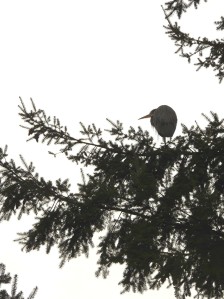

 There is a single Great Blue Heron colony in Bellingham, located in Fairhaven, near the dog park and water treatment facility. The birds fly from their nests to the nearby bay, where I have been most fortunate to see them foraging for fish while I have been out tide-pooling at Marine Park. No matter how many times I see them, I never get over the awe. A few days ago, our local paper posted an article on how an illegal trail through the colony was threatening the colony, who last year suddenly abandoned their nests in mid-season. Yesterday, I watched as one or two unruly dogs attempted to run the fence that protects the colony, with the herons standing at full alert.
There is a single Great Blue Heron colony in Bellingham, located in Fairhaven, near the dog park and water treatment facility. The birds fly from their nests to the nearby bay, where I have been most fortunate to see them foraging for fish while I have been out tide-pooling at Marine Park. No matter how many times I see them, I never get over the awe. A few days ago, our local paper posted an article on how an illegal trail through the colony was threatening the colony, who last year suddenly abandoned their nests in mid-season. Yesterday, I watched as one or two unruly dogs attempted to run the fence that protects the colony, with the herons standing at full alert.
Here are a few pictures I took a couple of months ago, when the herons had begun to return to the colony, but before the herons were nesting.
The most photogenic of all invasive species birds: European Starlings.
March 22, 2009Just try to get a lousy photo of these guys.. just not possible. They enjoy attacking the suet when they are not busy attacking each other… seems like sharing was not a skill set they learned from Mom and Dad.
More Peanuts….More Jays
March 22, 2009Put out more peanuts, got more Jays…simple supply and demand…. I supply and they demand. They are too cute to refuse.
Stellar Jays….the peanut theives
March 22, 2009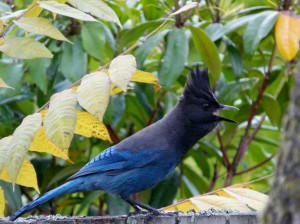
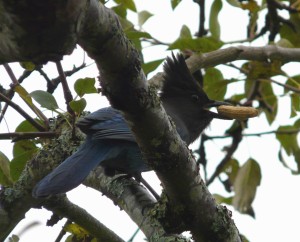
 One of the loudest and most colorful birds I have attracted to my feeder have been the Stellar Jays. Just put out a few unshelled peanuts and they begin to form a line on the fence next to the platform feeding… one flies in and stuffs as many peanuts down his gullet before flying off, leaving the next Jay in line to do the same. I used to dislike their loud screams until I realize that they were warding off the hawks and gulls that would try to visit the feeder.. now if I can only get them to do the same thing for the neighbor’s sneaky little cat.
One of the loudest and most colorful birds I have attracted to my feeder have been the Stellar Jays. Just put out a few unshelled peanuts and they begin to form a line on the fence next to the platform feeding… one flies in and stuffs as many peanuts down his gullet before flying off, leaving the next Jay in line to do the same. I used to dislike their loud screams until I realize that they were warding off the hawks and gulls that would try to visit the feeder.. now if I can only get them to do the same thing for the neighbor’s sneaky little cat.






 Posted by qwerty0
Posted by qwerty0 


























